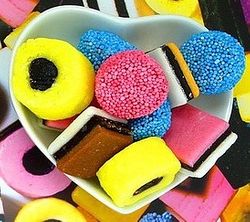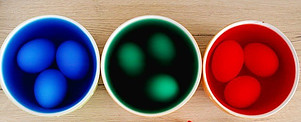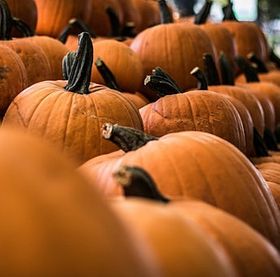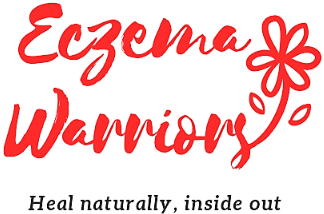Before I lived eczema through my children, I never batted an eyelid to eating all the processed foods with tons of additives. I have since learnt. A lot. This article is part of a series that discusses allergies to food additives, with particular focus on food dye side effects.
The other articles in the series can be found here:
- Allergies to Food Additives – Preservatives (trans fat, BHA/BHT, sulfur dioxide and sulfites)
- Allergies to Food Additives – Flavour Enhancers (MSG, aspartame, high fructose corn syrup)
- Allergies to Food Additives – Texture Enhancers
Why food dye, and what are they made of
The reason is obvious. It is to colour the food, so that it looks attractive. Eating is not just about the taste and the smell. It is a whole sensory experience involving sight and texture as well. Processed food manufacturers add food dyes to the food so that more people will be attracted to buy them. Imagine grey sausages? Or dull beige colour potato chips?
Most synthetic food colourings use petroleum or crude oil as a base. It is so much processed that frequently, very little of the original petroleum is found in the finished food dye. But still, I find it hard to stomach the fact that I had been eating petroleum in my cakes and cookies for the past few decades!
I questioned, why synthetic food dye when nature is so full of vibrant colours? From the manufacturers’ point of view, the answers are simple: cost, versatility, and shelf life.
It is much more cost effective to mass produce food dyes in the factories, with a common base which is petroleum, than to extract them out of nature, which requires different methods of extraction for different colours from different plants. Moreover, not every substance in nature can be made into a food dye, hence there are practical constraints when it comes to choices and versatility. Lastly, synthetic food dyes have a much longer shelf life than colours extracted from nature.
So I can understand where the food manufacturers are coming from, in using synthetic food dye. But it doesn’t mean I agree with their lack of principle when it comes to the interest of their consumers’ health.
Types of foods containing food dye

This list is not exhaustive, in fact if you really want to list them, it is endless. In general, any processed food will have a possibility of containing food dye. So keep your eyes peeled on the ingredients list.
- candies
- chocolate that are colour-coated
- popsicles
- ice cream
- cakes
- biscuits
- crackers
- frosting
- sprinkles
- beverages, like soda and packet juice
- canned food
- per-packed meals
- sausages
- even some medicines! (like liquid antibiotic)
Types of food colourings

These are the food colourings approved by the U.S. Food and Drug Administration:
- blue #1
- blue #2
- green #3
- red #3
- red #40
- yellow #5 (tartrazine)
- yellow #6
The list is short, but the harm goes a long way.
The harmful effects on us
Food dyes have been linked to allergic reactions, hyperactivity in children, and even cancer.
Blue #2, Red #40 and tartrazine (in particular), are known to trigger allergic reactions such as swelling and hives, eczema flares, allergic rhinitis, and even asthma attacks. Serious anaphylactic reactions have been linked to food dyes, so the danger is there for sure.
Food colourings are known to affect children behaviour in general, leading to hyperactivity. Children who took foods with colourings were observed to be overactive, inattentive, and impulsive. So that leads to an issue of public health. There have also been some controversial studies that point to children with ADHD (attention-deficit / hyperactivity disorder) being more sensitive to food colourings.
Red #3 caused cancer in rats. Red #40, tartrazine and yellow #6 are tainted with cancer-causing contaminants. Evidence has also suggested a link, though not proven yet, between blue #1, blue #2 and green #3 to cancer in animals.
So really, I’m not sure where the food industry is sending the world to, with all these harmful food dyes which are not necessary, but just to make the food look more appealing so that people will buy them.
Natural alternatives (limited choices)
If you really want your home made meals or party food to look vibrant and appetizing, do go for natural colourings. Even though the choices and variety of colours may be limited, but I’m sure the party-goers will appreciate your sincere efforts to take care of their health. I’m sure no one will miss the brilliant blue icing on the cupcakes.
We had used purple sweet potato in one of the children’s birthday cakes before! It’s strange that the dark purple from nature looked more artificial than the regular brown, yellow, or green coloured cakes that we are so used to! The guests were surprised by the colour, but happy to be fed healthy food, and wasted no time in chomping it all down!

Some examples of the beautiful colours from nature:
- purple: sweet potato, grape, blueberry
- red: beetroot
- orange: pumpkin, carrot
- yellow: turmeric, saffron
- green: matcha, spinach
- brown: cocoa, tea
- black: squid ink
Go for wholesome, unprocessed foods
This is what your diet should mainly consist of – wholesome, unprocessed foods. Fruits, vegetables, grains, herbs and spices. A little bit of meat if you must.
Many treats can be home made. We have made our own ice cream, pasta sauces, cakes, and cookies. Making these at home means we have total control over what goes into the foods. We know there will be zero additives like preservatives, MSG, aspartame, and food dyes.
If you really need a convenient food, for being on the go, or emergency situations which arise and render you not able to prepare some meals from home, then we have this healthy recommendation: Weet-Bix. No additives, minimally processed, just grains pressed together to make a healthy snack.
Other times, just stick to the trees, bushes and the fields, and you won’t go wrong.

I was aware of reds and yellows having carcinogenic properties (i have 2 cats and refuse to feed them anything with food coloring) but i didn’t know about the excema and adhd! funnily enough, i have both excema and adhd so i’ll have to keep those alternatives in mind!
Hi Rain,
Yes these food dyes really can wreck havoc to our systems, because they don’t belong in living bodies, cats or humans. Your cats are blessed to have you look out for them through their diet.
All the best to your health.
I had no idea that many food dies can cause health issues including eczema. Thank you for this knowledge I will have to be more careful especially where my children are considered.
Hi Tim,
Yes, do be careful with the kids. Their bodies are much more sensitive than ours.
Thank you for dropping by and reading the article.
Wow! This is a lot of great information! I never even thought about the food colors/dyes in our food. It’s no wonder that we suffer from so many health issues; “we” as in the population. I will be more aware now thanks to you. I will be sure to forward this post to others as well.
Best of health,
Devara
Hi Devara,
Thank you for dropping by. I’m so glad the article has alerted you to the health dangers of food dyes. More people need to know this, thank you for passing the information on too.
All the best to you.
Hello Joo, I love the information that you have provided in your article, very informative indeed!! I was unaware that several food coloring can cause eczema, which is what I have now. I’m using Cortizone 10 to get rid of this. I try not consume too much artificial foods, and try to eat lot of natural and organic products instead. Thanks again, and continue to do what you do!!
Hi Ahmad,
Oh I’m so sorry that you have eczema too. I just want to point out that steroids will only cover the symptoms by suppressing the inflammation, it is actually not good for long term use. You can read about my kids’ steroid withdrawal journey here: http://eczemawarriors.com/say-no-to-steroid-for-eczema
You’re certainly headed in the right direction to consume mostly natural and organic foods.
Take care, and heal naturally.
Ok, I did not know that food dyes contained food dye! That is just yucky, kind of like the ingredients in a Wendy’s frosty, which has no cream LOL. Thank goodness, I don’t even own any food coloring, and about 95 percent of our foods do not come from a packaged meal or frozen type food. I just learned that it is better to eat natural. I like your alternatives for color though 🙂 Wonderful ideas!
Hi Matts Mom,
Wow it’s fantastic that 95 percent of your foods are not packaged or frozen type foods, and they’re mostly natural! If more people could be like you, there may not be so many diseases around, especially chronic ones. I do own food coloring, but I’m happy to say it’s only for the kids’ art and craft projects, not to color our foods.